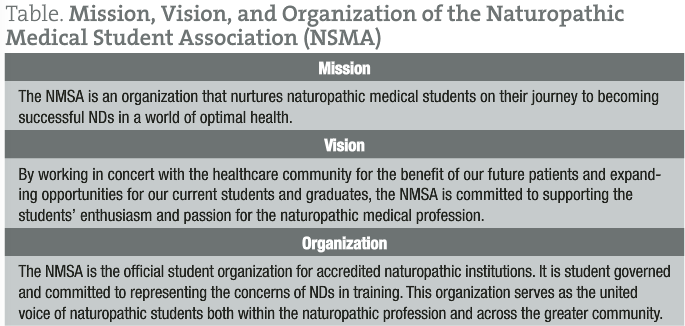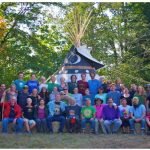The Voice of Our Students as They Learn the Vis
David Schleich, PhD
It is not widely remembered, except by those who were there, that 10 naturopathic students converged in the fall of 1998 on Bayview Wildwood Resort in Port Stanton, Ontario, Canada, 100 km north of Toronto to form an international association of student leaders. The host college in Toronto, Canadian College of Naturopathic Medicine (CCNM), brought together students to create the International Naturopathic Students Association (INSA), representing National College of Natural Medicine (NCNM [Portland, Ore.]), Bastyr University (Seattle, Wash.), University of Bridgeport College of Naturopathic Medicine (UBCNM [Bridgeport, Conn.]), and Southwest College of Naturopathic Medicine (SCNM [Tempe, Ariz.]). Two student organizers, now successful physicians in British Columbia and Colorado, respectively, Heli McPhee, ND (CCNM), and Mark Carney, ND, LAc (Southwest), led the closing ceremony on the beach at Wildwood Lake. Two artifacts still exist from that ceremony: a sealed jar of water, blended from every campus, and a sealed jar of earth, blended from every campus.
This year, 13 years later, the seventh annual Naturopathic Medical Student Association (NMSA) conference was held at the Arizona Biltmore, in Phoenix, frequent site of the annual conference of the American Association of Naturopathic Physicians (AANP). This remarkable trajectory arose from the vision and industriousness of student leaders, such as NMSA cofounder Jonci Jensen, ND (Austin, Tex.), who resurrected the idea of an international association of naturopathic students and, along with pioneering colleagues, created an association that is now a movement. Dr. Jensen, then a student, attended the American Medical Student Association (AMSA) National Convention in 2005 and took action to create a similar organization for naturopathic students. Soon, other student leaders joined the effort: Alexis Chesney (UBCNM), Jaclyn Chasse (Bastyr), Corinne Sell (NCNM), Cheri King (NCNM), and Leila Fosdick-Turner (SCNM).
By late 2007, Cheri King took office as the first elected NMSA president, and the NMSA became an official affiliate of the AANP. In short order, the NMSA also became a member organization of the Naturopathic Coordinating Council and a participant group in the Academic Consortium for Complementary and Alternative Health Care. Soon thereafter, the NMSA held an ex officio seat on the board of the Institute for Natural Medicine and developed a formal liaison role with the AANP and the AMSA. By 2008, the group has distinguished itself so effectively as an important and growing element in the formation of the naturopathic profession that an equally visionary leader, Dr. Lise Alschuler, then president of the AANP, awarded the NMSA the 2008 AANP President’s Award at the annual AANP conference held that year also in Arizona. The NMSA was incorporated in the state of Oregon and, at the invitation of NCNM, established its headquarters in Portland.
In that same year, NCNM asked the emerging group to be the formal liaison and organizing body for the ZRT Cup (sponsored by ZRT Laboratory, Beaverton, Ore.), a celebrative competition showcasing the remarkable knowledge and skills of our emerging physicians and leaders. In the same spirit, 2 years later NCNM asked the NMSA to add the Bob’s Red Mill Intercollegiate Cup (sponsored by Bob’s Red Mill, Milwaukie, Ore.) to its NMSA bailiwick. In that same year, the NMSA began the process of approvals to generate a system-wide student fee in support of the organization’s efforts and potential growth. Bill Benda, MD, then a member of the AANP board, and Dave Matteson, AANP advisor, coached the NMSA leadership on its organizational development.
What began at Wildwood Lake amid the riot of autumn colors and encroaching northern winter in 1998 had within a decade emerged as an important voice for the steadily growing cohort of new, mostly young NDs preparing for careers in naturopathic medicine. While they learned the vis, they had a voice (Table).

It is not surprising that a student leadership and advocacy organization not only is flourishing now but also is increasingly sought after as the key point of advocacy for naturopathic students. It is not unexpected that the NMSA is in steady formation alongside the maturing of the profession itself in the United States and in Canada. It is not inconsistent with how professions take shape in civil society that NMSA leaders so early on are consistently distinguishing themselves as present and future catalysts of the profession.
During the 4-day Wildwood Lake INSA retreat, Dr. John Cosgrove, a Canadian naturopathic pioneer, told the story of Rudolph Virchow. A noted German allopathic physician in the 19th century, Virchow is known as the father of pathology. Dr. Cosgrove spoke of “Virchow’s node” and “Virchow’s triad” and of an old campaign against cholera. Dr. Cosgrove celebrated the hard medical work of Virchow but also went on to point out that Virchow was a German revolutionary, who risked everything to be active in the 1848 revolution to overthrow the Prussian king and establish a democratic republic. Virchow was not only a physician in his time but also an advocate for social change. He proclaimed widely that the wretched living conditions in the Prussian Empire derived from the social policy of the elite in that country and that “healers” had a duty to fight to change social policy. Dr. Cosgrove reminded the group on the beach that evening, before a wonderful campfire, just ahead of singing and late-night s’mores, that it was Virchow who said, “Medicine is, above all, a social science, and politics is medicine practiced on a grand scale.” Dr. Cosgrove added that the biomedicine profession had broken its social contract and it was up to others to restore altruism to the “dominant healing professions.” He called on the INSA student leaders to take up that challenge. Dr. Cosgrove, a pioneer in naturopathic professional formation in Canada (one of the founders of the modern CCNM, former chair of the board of CCNM, and current chair of the board of Boucher Institute of Naturopathic Medicine [New Westminster, British Columbia, Canada]), has never faltered from the work. The student leaders he was so proud of are continuing that work now in the form of the NMSA.
Shortly after Dr. Cosgrove’s talk, Heli McPhee and Mark Carney led the group in what they described as a “first sharing.” Student representatives from the five schools had brought with them earth and water from their campuses. They blended and sealed a jar of water and a separate blended jar of earth, from rivers and campus gardens in Oregon, Washington, Connecticut, Arizona, and Ontario. The intent was to add to each jar, to make even bigger jars, each year, with these “emblems of our healing roots.” What those early INSA leaders wanted to create was a dynamic symbol of the grounding of the profession in the face of complex, ever-changing circumstances.
As listed in a 2009 NMSA brochure, students of the NMSA serve to:
- Promote principles of naturopathic medicine to establish a better understanding of health in our communities
- Improve the standard of healthcare
- Educate the greater community about our medicine
- Encourage communication and collaboration among students at all naturopathic colleges
- Provide a platform for student activism and advocacy
These student leaders have an impressive, ambitious, and important agenda. They know of and want to do something about system-wide issues, such as the following:
- Health system reform
- Medical student debt
- The urgent need for funded postgraduate medical education (residency) opportunities
- The urgent need to educate naturopathic medical students and recent graduates about issues in public health and health policy
- The urgent need for leadership training to encourage activism and leadership in local communities
Several years ago at NCNM, I met regularly with NMSA leaders who were hard at work creating their organization. The conversations were robust and energizing and included debate about relevant issues big and small. I recall point-counterpoint about the tension between nature cure and green allopathy. I recall one feisty conversation about why mainstream physicians were less likely to vote than members of other professions (Landers & Sehgal, 2004). The student raising this issue insisted that the allopathic track record was such that the MDs “are active as advocates primarily when it affects their own reimbursement” (see Pellegrino & Rehlman, 1999) but that many of their AMSA counterparts were “not going down that well-beaten, obvious path.” These same NMSA pioneers also expressed dissatisfaction on many scores with practice and with academia. There were several conversations I remember about a “hostile workplace” environment for NDs in so many states and provincial jurisdictions and potshots at the administration and faculty of the schools for not equipping graduates better for that difficult road ahead. There was also talk of what “professionalism” meant. During one meeting of the local NMSA chapter at NCNM, the following impressive list of qualities was compiled about what constituted a profession, a framework that could be used by the Canadian Association of Naturopathic Doctors or the AANP with alacrity:
- It possesses a discrete body of knowledge and skills
- It requires a long period of education
- Its members determine educational requirements and admission to the profession
- It evaluates and disciplines its members
These young people always had much to talk about and do. They created a comprehensive chart of licensing and regulatory frameworks for both the naturopathic and Traditional Chinese Medicine professions across America and Canada. They did not stop there. They talked about why it was important that ND students expect to earn a reasonable living, despite an often acrimonious economic terrain, about why NDs should be expected to “value performance above reward,” why NDs “have to be held to higher standards of behavior than nonprofessionals” and that NDs should be “expected to behave in an ethical fashion throughout their careers” without “deference to Big Pharma, health maintenance organizations, for-profit insurance businesses, and the competing biomedicine system.” They were instrumental in helping assemble the historical time line display in partnership with the Foundations of Naturopathic Medicine project.
American educator Peter F. Drucker wrote: “Management is doing things right; leadership is doing the right things.” The NMSA’s action plan and impressive list of accomplishments are not only prescient but also instructive. The NMSA leaders speak too about what is the core of the profession they want to belong to and about how their profession has to be grounded in altruistic, professional behavior, characterized by placing the interests of the patient above self-interest. Dr. Cheri King, for example, a tireless early leader of the NMSA, asserted more than once that “a profession has to place societal interest above the interest of the profession itself.” She also insisted that the allopathic world of managed care with unrelenting changes in practice patterns and decreasing reimbursement, growing paperwork, and government interference was potentially as distracting and harmful to new NDs as to MDs, especially as these variables affect patient care. Our NMSA student leaders are dialed in.
In a number of conversations I have since had with NMSA leaders from several schools, it has become clear that this body already understands the critical importance of education and information about public health policy issues, about timely grassroots political and legislative activism, and about dissemination of information, facts, and data in support of professional formation. The NMSA leaders I have come to know totally get the urgent need for building professional networks during medical school and beyond, especially given pressing concerns about student debt loads, variance in curricula, the importance of establishing a medical academic career path for naturopathic medical educators, the confusing landscape of healthcare reform and its impact on future practice, and the complexity of global health issues.
Watch this emerging “agency” of naturopathic professional formation provide increasing leadership on a national scale about these issues. They are collectively abreast of trends in leadership training for healthcare professionals. One NMSA member sent me an article recently about “developing leadership and advocacy skills in medical students” that explained how this could be accomplished through “service learning” and asked at the same time how to raise money to make it all happen (Long et al., 2011).
The NMSA is steadily awakening to its role as a national training ground for naturopathic leaders. These physicians in training are building capacity to equip, motivate, enable, and empower students and recent graduates to do something about developing the ability to rise above self, to understand and disarm circumstances, to overcome obstacles, to change themselves, and to avoid the threat of the crowd. The current $25 fee for membership should grow 10-fold in the coming years, enabling significant investment in managerial and leadership skills building, organizational capacity, and branding.
 David Schleich, PhD is president and CEO of NCNM, former president of Truestar Health, and former CEO and president of CCNM, where he served from 1996 to 2003. Previous posts have included appointments as vice presi-dent academic of Niagara College, and administrative and teaching positions at St. Lawrence College, Swinburne University (Australia) and the University of Alberta. His academic credentials have been earned from the University of Western Ontario (BA), the University of Alberta (MA), Queen’s University (BEd), and the University of Toronto (PhD).
David Schleich, PhD is president and CEO of NCNM, former president of Truestar Health, and former CEO and president of CCNM, where he served from 1996 to 2003. Previous posts have included appointments as vice presi-dent academic of Niagara College, and administrative and teaching positions at St. Lawrence College, Swinburne University (Australia) and the University of Alberta. His academic credentials have been earned from the University of Western Ontario (BA), the University of Alberta (MA), Queen’s University (BEd), and the University of Toronto (PhD).
REFERENCES
Landers, S. H., & Sehgal, A. R. (2004). Health care lobbying in the United States. American Journal of Medicine, 116(5):474-477.
Long, J. A., Lee, R. S., Federico, S., Battaglia, C., Wong, S., & Earnest, M. (2011). Developing leadership and advocacy skills in medical students through service learning. Journal of Public Health Management & Practice, 17(4):369-372.
Pellegrino, E. D., & Relman, A. S. (1999). Professional medical associations: Ethical and practical guidelines. The Journal of the American Medical Association, 282(10):984-986.





